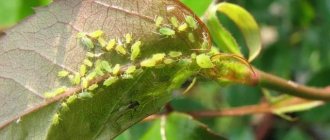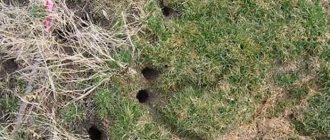Why am I getting rid of the mole cricket?
I always treat garden pest control responsibly. After all, the inattention and carelessness of a gardener often threatens with the death of cultivated plants and the destruction of a significant part of the harvest.
The mole cricket is not the last enemy here. It is also known as cabbage grass, top grass, earthen crayfish, and mole cricket. Based on its body structure and chitinous “shell,” this insect can be confused with a small cancer. The pest sometimes reaches the length of a human palm. But, unlike aquatic inhabitants, it has a pair of wings that allow it to overcome significant distances and water obstacles.
The insect is armed with tentacles and powerful jaws. This “property” makes it unusually voracious - in a season the top can destroy several hectares of plantings. The pest is very prolific - over the summer, two individuals leave numerous offspring, whose number goes into the hundreds.
I do not allow mole crickets to appear on my site for a variety of reasons. The insect gnaws through the root system of various plantings, spoils root crops, and destroys planted seeds. It does not disdain leaves and stems of young plants, and destroys beneficial earthworms.
Anatomy and activity of pests
The mole cricket is a major pest of the order Orthoptera.
Its body consists of a cephalothorax and abdomen and can reach 6 cm in length. The insect is covered with a dense shell, due to which it received the name “earthen crayfish”. Mole cricket is dangerous for all crops grown in the garden, but it is especially dangerous for the roots of tomatoes, cabbage, carrots, bell peppers and potato tubers. The insect eats the root system of the vegetable, which leads to its death due to the inability to obtain nutrients from the soil
On the head there are two large eyes, antennae and tentacles. The front legs are short, but quite powerful, as they are designed for digging underground passages. At the end of the abdomen there are two processes up to 1 cm long.
The pest has elytra and large wings, thanks to which it moves well through the air. In addition, he swims well and runs fast, but still prefers to spend most of his life underground.
The life cycle of a mole cricket is quite complex. During the mating season, which lasts from May to June, females build nests and lay eggs. One clutch can contain up to 500 future larvae.
The nest is located at a depth of 10-15 cm and looks like a small earthen lump with an internal chamber. For the proper development of eggs and the formation of larvae, high humidity is required, which is controlled by the female, closing the entrance hole if necessary.
After 10-18 days, larvae emerge from the eggs. Outwardly, they are similar to adults, but are distinguished by their size and lack of wings. After leaving the nest, the young generation moves through ready-made tunnels, feeding on organic remains. After 10-12 months, the young reach the size of a large individual and are able to dig underground passages themselves.
The cabbage moth/mole cricket is an insect that reaches 5-8 cm in length, has a dense shell and spends most of its time underground. It reproduces actively and moves quickly over long distances
The appearance of a mole cricket in a summer cottage can be detected by three signs:
- wilting of plants;
- the appearance of deep holes with a diameter of up to 1.5 cm on the soil surface;
- the presence of earthen paths that are clearly visible after rain or watering.
Having noted these signs in your area, take measures to combat the pest. This will save the harvest and prevent the rapid growth of the cabbage plant population.
The crustacean/mole cricket is dangerous for the crop - it eats up the tubers and roots of vegetable crops, which leads to their withering and death. Just a couple of bugs can “mow down” a fairly large planting area
What does a bear look like: photo
An adult mole cricket is impressive in size for an insect. With an abundance of food, it can reach 5-6 cm in length. The front legs resemble short, thickened claws, only they are not forked, like a crayfish, but have 4 powerful teeth. She uses her paws like shovels to dig underground passages. There are 2 more pairs of paws on the abdomen. The hind ones are the longest, like those of a grasshopper.
The hard, chitinous dorsal covering of the body of an adult is dark brown in color and appears shiny due to numerous golden hairs. The mole cricket has a wide head and a long (almost 3 times longer than the head) abdomen. The head contains strong jaws, tentacles, large eyes and long whiskers. Under the knees of the front legs in a deep fold are the ears.
What does a bear look like (video)
The wings of the mole cricket are well developed; when folded, they appear to be bent downwards in cords and protrude from under the short elytra. Thanks to its wings, it can fly quite long distances. Lives underground, but at the same time, not only flies well, but also runs fast.
The mole cricket overwinters in compost heaps and in the ground, at a depth of 1 m; the larvae of the first year of life in winter do not fall lower than 20-25 cm. When the soil warms up to 12-15 ° C, the insect comes out of hibernation. Mating of insects occurs in the spring. Offspring will appear in warm weather in summer. Each nest can contain several clutches. Each clutch contains from 50 to 400 eggs. From oval yellowish-gray 2 mm eggs hatch wingless larvae, which in appearance are similar to gray six-legged spiders.
Mole cricket masonry
For the first 20 days of life, the larvae live in the clutch, and then crawl into burrows, make new passages and begin to actively feed on roots, fruits and seeds. When the nest is torn apart, it is clear that the grown larvae are very active, run fast, and can even jump. The age of the larvae is divided into several stages of molting: the youngest are 15 mm in length, the larvae of the 4th stage already have the rudiments of wings, the larvae molt up to 10 times. The larvae reach adult size only the following year. The full development cycle of the pest lasts 2 years.
Destruction of mole crickets in the garden
To effectively combat such a serious garden pest, you need to “know it by sight.” I’ll tell you about the life functions of the mole cricket:
- The insect is nocturnal. At this time of day, it gets out to the surface of the earth and changes its location.
- The mole cricket loves warm, moist soil, illuminated by the sun during the day. It prefers a substrate richly fertilized with manure, in which a “greenhouse effect” occurs.
- The insect is unusually prolific. Up to 500 larvae can hatch from one clutch of eggs. In terms of appetite, they can compete with locusts.
The first sign of a pest appearing in the garden is small areas that look like mown grass. The mole cricket cuts it off with its powerful jaws - it fights against shading, which interferes with the breeding of offspring.
signs of a mole cricket in the garden
Carefully monitor the pest operating in your garden - its burrows can be confused with manholes, passages of shrews and moles. But each of these uninvited guests has its own methods of struggle. Traps, bait, erection of natural barriers and the use of ultrasonic repellers are effective against mole crickets. They successfully fight pests using folk remedies.
If these methods are powerless, they turn to chemicals and biological poisons. If the use of such drugs is unsuccessful, “heavy artillery” is needed - a sanitary service specializing in large-scale pest control. Professionals work with powerful chemicals that literally destroy all life on the site. Therefore, turning to such a drastic remedy is justified only in case of a large invasion of earthen crayfish.
Reasons for appearing in the garden
The invasion of cabbage weeds in the garden can be facilitated by adding fresh organic fertilizer to the soil, regardless of whether the product was applied to increase the fertility of the soil on your own plot or on a neighboring one. Mole crickets can overwinter in any manure, although some gardeners claim that fresh chicken manure is used specifically to get rid of the pest. The second reason for the appearance of cabbage mushrooms can be waterlogged mulched soils, as well as lands where groundwater is located near the surface layer.
Chemical methods
Chemicals designed to combat garden pests contain potent poisons that are dangerous not only for insects, but also for humans. Therefore, I recommend that you pay attention to the following precautions:
- Carry out the treatment when there are no small children or pets on the site.
- Take care of your own safety: wear thick rubber gloves, closed clothing and shoes, a respirator, a hat and safety glasses.
- Use separate containers and tools for processing. Clean and store these items separately.
- Follow the manufacturer's instructions exactly - do not exceed the dosage.
Chemicals can be divided into two groups:
- Granules: “Phenaxin Plus”, “Thunder”. The products do not require dissolution in water - they are scattered in mole cricket burrows and placed in sweet baits. The insect eats the “delicacy” and dies from the poisons it contains. Granular preparations are highly effective, but very toxic. Eating them by pets, beneficial insects and birds leads to serious poisoning or even death.
- Powders for preparing solutions: “Masterpiece”, “Akara”, “Prestige”. From a spray can or spray bottle, the product is sprayed onto the seeds and root system of seedlings. The drug acts already in the substrate, without harming the harmless terrestrial inhabitants of the garden.
I will present the drugs against mole crickets that are popular in garden centers:
- "Sarin";
- "Antimedvedka";-
- "Boverin";-
- "Medvetox";
- "Grizzly";
- "Frontier";
- "Medvecid";
- "Regent";
- "Rubit Rofakoks";
- "Rembek".
An alternative to chemicals is biologically active drugs. These substances contain spores of pathogenic fungi that are deadly to mole crickets. Once in the insect's body, they begin to actively reproduce. The activity of fungi leads to the subsequent death of the mole cricket.
Folk ways to get rid of mole crickets
The use of folk remedies against mole crickets has an important advantage - these methods are safe for humans and plants. But they are effective only in the early stages of a pest invasion. If the mole cricket has bred in impressive quantities, it is impossible to do without the use of pesticides.
Kerosene against mole crickets
The old-fashioned way to fight earthen crayfish is to use sand and kerosene. The method is especially good for expelling the pest from the greenhouse.
For 1 m2 of ridge, 1 kg of sand soaked in 50-70 ml of kerosene is required. It is important to thoroughly mix the mass several times: first with the “fragrant” additive, then sand with several shovels of garden substrate. The mixture is recommended for use when planting seedlings and sowing seeds. Holes and furrows are filled with kerosene soil and scattered over the surface of the ridge.
Soapy water
It is possible to get rid of the pest by scouting out the location of its passages. You need to prepare a soap solution, add a little vegetable oil to it (1:10). 1 liter of liquid per mink is enough. An insect, taken by surprise, will hasten to get to the surface. The gardener will only have to destroy it.
I recommend using laundry soap shavings to prepare the solution. Foam from washing powder, shampoo, shower gel, and dishwashing detergent is by no means a useful “fertilizer” for your garden. Such products will saturate the earth with synthetic additives, flavors, and bleaches.
Protective rings
Around individual ridges or greenhouses you can make protective rings - a kind of “right of way” for mole crickets. To do this, ditches and furrows up to 20-50 cm deep are dug. They are covered with crushed eggshells, stove ash, sawdust, broken glass, and brick fragments. To increase efficiency, the contents are filled with kerosene.
Eggshell
You can take advantage of the mole cricket’s gluttony by preparing a “delicacy” for it from spicy crushed eggshells. Pour the shards with aromatic oil - unrefined or homemade. Place the shells in furrows and holes before planting seeds or seedlings.
This product “kills two birds with one stone.” Having eaten sharp fragments, the top will die. And eggshells will serve as a good fertilizer (a source of calcium) for future plantings.
Karbofos
Mole crickets are not averse to eating seeds and grain. Resourceful gardeners prepare the following “treat” for them:
- 1 kg of grain oats, wheat, peas, corn or bran;
- 50 g karbofos;
- 30 g unrefined vegetable oil.
Baits are poured into burrows and insect holes. You can spread them on the surfaces of the beds, but in this case the poison can be eaten by beneficial insects and birds.
If there is a massive invasion of cabbageweeds in the area, it is recommended to water the places where they accumulate with one solution of karbofos. It is important to follow the dosage so as not to destroy all living things in the garden. Carry out the treatment late in the evening, when beneficial insects are already sleeping.
Calcium carbide
Gardeners successfully wage a “chemical war” with mole crickets: they find the pest’s holes and place 5 g of calcium carbide there. Upon contact with groundwater or rainwater, a violent reaction occurs. Acetylene is released, filling all the passages of the mole cricket. With such chemical exposure, the uninvited guest dies.
calcium carbide application in the garden
Traps
When turning to this method of control, be prepared that you will have to manually destroy these impressive insects. Traps are based on the pest's taste preferences. “They know honey” - they love to eat sweet things: honey, sugar syrup, jam.
Let me present a simple way to build a bait:
- Coat the mouth of a glass jar with sticky sweet bait. Pour some syrup inside.
- Dig baits around the perimeter of the site, on the paths. The neck of the container should be level with the ground.
- At night, an insect, attracted by the appetizing smell, will fly in and crawl into the jar, but will stick to the sweet syrup at the bottom and will not be able to rise into the air.
Another bait option is jars filled to the brim with water with the addition of a spoonful of vegetable oil. Once caught in such a trap, the insect will not be able to emerge - the oil creates a film that prevents the flow of air.
The bear also likes beer. A small hole is dug for the trap. A jar or bottle with a wide neck is buried at an angle in one of its vaults. A little beer is poured into the container. The bottom of the hole is watered and the hole is covered with a sheet of iron, plywood or tiles. The insect will have no chance to get out and fly away.
Gardeners take advantage of mole crickets’ addiction to warm manure. During autumn digging, several holes up to 0.5 m deep are made in the area. They are filled with half-rotted horse manure, mullein mixed with straw. The mole cricket will find a cozy haven in the trap. Before the onset of frost, it is enough for the gardener to remove the manure contents from the pits and destroy the pests that have settled in for the winter.
fighting mole crickets with manure
The traps are checked every 5-10 days - the mole crickets they catch are taken out and destroyed. Renew the sweet bait and bury it in a new place. It is enough to place the traps at a distance of 4-5 m from each other.
Reviews
The mole cricket is a very persistent pest - dozens of methods to combat it are known and described both in the world and on the Internet. Almost all of them are based on the introduction of chemicals and even kerosene into the soil. What kind of environmentally friendly products can we talk about using this chemistry? The mole cricket lives only in acidic soils. The soil needs to be “deoxidized” by adding plenty of lime and dolomite every year; if there is acidic perched water nearby, as in peat bogs, drainage should be done, and sand and neutral soil should be added to the peat. The mole cricket will disappear. Tested in practice by gardeners.
erasim
https://houseinform.ru/forum/kak_borotsya_s_medvedkoy
At our dacha, we usually dig 1.5–2 liter bottles with the neck cut off into the ground. The neck should be level with the ground. And fill it halfway with water. 3-4 pieces fall per night, and sometimes more. I heard that beer is better instead of water, but I haven’t tried it.
osa5
https://houseinform.ru/forum/kak_borotsya_s_medvedkoy
I struggled as follows. You dig a hole a bayonet to one and a half shovels deep and a meter by a meter around the perimeter. At the bottom you throw fresh manure, preferably horse manure, at least 15–20 cm thick, and on top there is the same amount of straw and 20–25 cm of soil. It turns out like a greenhouse. In the fall, mole crickets crawl from all over the garden to bask and lay eggs in this warmth. At minus 5-6 degrees, I dug up this trap and there were just tons of them there! Everything was put into a barrel and burned. I got everything out in two years. Only this must be done together with your neighbors 100 meters in all directions from your garden. Otherwise it’s like cockroaches. You starve them, they disappear for a couple of weeks, and then they come again from the neighbors. By the way, you need one of these holes for every 3–4 acres of garden.
Goodwin
https://forum.homedistiller.ru/index.php?topic=1813.0
The mole cricket is a worse attack than moles: when I was hilling up the cabbage for the first time, I saw eggs similar to those of an ant, although larger. While hilling the cabbage another time, I noticed some unusual large ants. I took a closer look, and these are tiny mole crickets. There were several hundred of them. He opened the nest, walked away, and the birds immediately flew in and ate them. He turned the earth for a long time until there was nothing left. The cabbage, near which I found this nest, was depressed. After this, he often determined by the type of plant where the mole cricket’s nest was.
Kazak
https://farmerforum.ru/viewtopic.php?t=760
Mole crickets love warmth and the smell of manure. A lot of them accumulate there. In the fall, you need to dig a hole and throw manure into it. There will be a lot of mole crickets there - they will spend the winter there. When frost sets in, you can scatter this manure on the ground and the insects will all freeze. Another option is to burn this manure in the spring. The mole crickets will also die. They are also very afraid of soapy water. Pour a strong solution of water and laundry soap into the holes. The earthen crayfish will come out and you will chop them up with a shovel. And if they don’t make it to the surface, they’ll die there.
Vika Luzina
https://farmerforum.ru/viewtopic.php?t=760
Few people know, but the hedgehog is a natural fighter of mole crickets. Just get a hedgehog and don't forget to give him a home in a quiet place.
Anatoly Gorobets
https://farmerforum.ru/viewtopic.php?t=760
Of course, it is unpleasant to find this prolific and voracious insect in your garden. But don’t despair - a large arsenal of industrial and folk remedies will help you cope with the problem and get rid of the mole cricket forever, or at least minimize the damage from its presence.
Ultrasonic repellers
A modern universal way to combat garden pests is ultrasonic repellers. These products will save your area not only from mole crickets, but also from moles, rats, and shrews. The device emits signals that are not audible to the human ear, but are completely intolerable to pests. The constant broadcast of unpleasant sounds forces mole crickets to leave your area.
However, gardeners have ambivalent assessments of such means. It is enough to turn off the device, and the area again becomes defenseless against pests. Moreover, some insects “get used” to ultrasound, and it ceases to be an obstacle to crop destruction.
ultrasonic repellers against garden pests
Preventing the appearance of mole crickets
In order not to waste time on energy-consuming fight against crayfish, I recommend paying attention to simple but effective means of preventing the appearance of the pest:
- Careful autumn soil cultivation (digging, loosening). During this procedure, the pest eggs are forced to the surface of the earth and destroyed. The insect rarely returns to the area where its passages and usual living conditions have been destroyed - it flies away to look for a more favorable place.
- Construction of natural barriers along the perimeter of the site. The pest will not be able to “break through” the developed root system of shrubs and trees. The pest especially does not like bird cherry and alder. If you do not have the opportunity to plant these trees, make stakes from their branches without stripping the bark. Stick the sticks to a depth of 20-30 cm, change them as they dry out.
- Planting garden flowers. Mole crickets cannot tolerate marigolds, chrysanthemums and calendula. Such a “green shield” can be planted along the borders of the ridges that are loved by the uninvited guest.
- Iodine opposition. Before sowing the seeds of parsley, carrots and other root vegetables, the furrows are shed with iodine solution: 20 drops per 10 liters of water.
- Onion and garlic. The mole cricket is repelled by the smell of onion infusion and mashed heads of garlic.
- Odor protection. The pest does not like the strong “aroma” of naphthalene and kerosene. These products are used to “flavor” the sand and scatter it around the perimeter of the garden. A rather radical method is to bury pieces of rotten fish in the ridges favored by mole crickets.
- Coniferous barriers. They also cannot tolerate the aroma of pine needles. Place fresh branches of spruce, pine, fir near the beds, change them as they dry out.
- Use of sound effects. Hang rattles, bells, bells, windmills, and pieces of magnetic tape around the perimeter of the site. The sounds they make repel pests.
- Attracting natural enemies. Birds include starlings, crows, storks, and rooks. Insectivorous animals include scolopendras, shrews, hedgehogs, ground beetles, and lizards.
The mole cricket is a rather dangerous enemy of the gardener. This is a prolific, voracious large insect with chitinous “durable” armor.
It digs out long underground passages and flies over impressive distances. To avoid encountering it on your site, do not forget about preventive measures. If the mole cricket has already settled in your garden, do not hesitate to destroy it. Otherwise, the uninvited guest will easily leave you without the long-awaited harvest.











